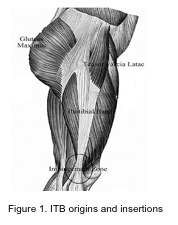The problem
- The Iliotibial band runs down the outside of the thigh from the hip to the knee, with its main muscular attachments being
 the gluteus maximus and tensor fascia latae muscles. It crosses the knee and attaches to the tibia, so that every time we flex and extend the knee, it flicks over the lateral epicondyle of the femur.
the gluteus maximus and tensor fascia latae muscles. It crosses the knee and attaches to the tibia, so that every time we flex and extend the knee, it flicks over the lateral epicondyle of the femur. - In English, it rubs across the part of the knee that sticks out. This constant rubbing can lead to inflammation and pain on the outside of the knee, known as Iliotibial Band Friction Syndrome (ITBFS).
Interesting facts
- ITBFS accounts for 12% of running-related overuse injuries.
- The two main causes of ITBFS are training/equipment errors and poor biomechanics.
- Training Equipment Errors:
- Rapid increase in distance covered
- Training on crowned/sloped roads
- Excessive time on the track
- Poor footwear that allows excessive and prolonged pronation of the foot
- Worn out footwear… as a guide, most shoes are good for 800km or 6 months
- Biomechanics
- Weakness and inflexibility in the gluteus medius has been noted in runners with ITBFS. With this the pelvis drops down on the side opposite the standing leg and tightens the ITB. Also, the knee rolls inwards & the ITB flicks over the lateral epicondyle with more ferocity.
- Weakness in the hamstring and quadriceps is also common
- Tightness of the ITB itself can be a factor, increasing pressure over the epicondyle at the knee
What you can expect/look out for
- A sharp burning pain on the lateral aspect of the knee frequently signals ITBFS.
- You can’t run through it – it gets worse the further you go!
Hints for self-management
- While rest is important to allow the inflammation to settle, ITBFS will likely return unless some changes are made
- Anti-inflammatory medication may help in the short-term
Management options
- Deep tissue massage may provide some relief, albeit, only short-term.
- A physiotherapist can tape the knee to provide support and relieve pain so you can continue training.
- The key to fixing ITBFS is a well-designed biomechanical program that provides for strength and endurance of the gluteal muscles and assessment and re-training of biomechanical errors in your running style. See the experts at SPS to set this program up and guide you through it.
- If necessary, a corticosteroid injection can provide pain relief, if the knee is not settling with more conservative treatment.
At Sydney Physiotherapy Solutions our highly qualified physiotherapists will work with you throughout the assessment, treatment and prevention of musculoskeletal injuries.
Contact us today – 9252 5770

